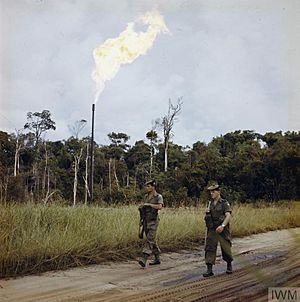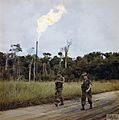Brunei revolt facts for kids
Quick facts for kids Brunei revolt |
|||||||
|---|---|---|---|---|---|---|---|
| Part of the beginning of Indonesia–Malaysia confrontation and Formation of Malaysia | |||||||
 Queen's Own Highlanders on guard in the Seria oilfield. |
|||||||
|
|||||||
| Belligerents | |||||||
| Commanders and leaders | |||||||
|
|||||||
| Units involved | |||||||
|
|||||||
| Strength | |||||||
| 2,000–6,000 | 4,000 | ||||||
| Casualties and losses | |||||||
| 6 dead, unknown civilian casualties | 40 dead (3,400 captured/ pardoned) | ||||||
The Brunei Revolt was a short but important uprising in December 1962. It happened in Brunei, which was then a British protectorate. People who opposed Brunei's ruler, the Sultan of Brunei, started the revolt. They also did not want Brunei to join the new Federation of Malaysia. Instead, they wanted to create a republic.
The rebels were part of a group called the TNKU (North Kalimantan National Army). This group was supported by Indonesia. They were also linked to the Brunei People's Party (BPP), which wanted a different union of Borneo states. The TNKU launched attacks on the oil town of Seria, police stations, and government buildings. However, the revolt quickly failed. The rebels could not capture Brunei Town or the Sultan, Omar Ali Saifuddien III. This event later led the Sultan to decide that Brunei would not join Malaysia. It is also seen as the start of the Indonesia–Malaysia confrontation.
Contents
Why Did the Brunei Revolt Happen?
Brunei's History and Wealth
The northern part of Borneo Island had three British territories. These were the colonies of Sarawak and North Borneo (later called Sabah). The third was the Sultanate of Brunei, which became a British protectorate in 1888. Brunei was quite small, about 2,226 square miles (5,765 km2). It had around 85,000 people. About half were Malays, a quarter were Chinese, and the rest were Dayaks, who are native to Borneo.
In 1929, oil was found near Seria. The Shell Petroleum Company's oil fields brought a lot of money to Brunei. The capital, then called Brunei Town, was located on a river.
Political Changes and New Ideas
In 1959, Sultan Omar Ali Saifuddien III set up a new government body. Half of its members were chosen by him, and half were elected by the people. In September 1962, elections were held. The Brunei People’s Party won all the seats that were up for election.
Between 1959 and 1962, the United Kingdom, Malaya, Singapore, North Borneo, and Sarawak talked about forming a new country called Malaysia. However, the Philippines and especially Indonesia were against this idea. They did not want North Borneo and Sarawak to join the new federation.
Local Opposition to Malaysia
Many people in Sarawak and Brunei also did not want to join Malaysia. The Brunei People’s Party wanted to join Malaysia only if the three British Borneo territories united first. They believed this new sultanate would be strong enough to stand up to Malaya or Singapore. People in Borneo felt they were different from Malaya. They had different economies, politics, history, and cultures. They did not want to be controlled by leaders from the Malay Peninsula.
The Rise of the TNKU
Before the Brunei People’s Party won the elections, a military group formed. This group was called the North Kalimantan National Army (TNKU). They saw themselves as fighting against colonial rule. They supported Indonesia, believing it offered better "liberation." Their 34-year-old leader, A.M. Azahari, had lived in Indonesia. He had connections with Indonesian intelligence. He recruited officers who were trained in secret warfare in Indonesia. By late 1962, the TNKU had about 4,000 members. They had some modern weapons and about 1,000 shotguns.
How Did the Revolt Begin?
Warnings of Trouble
In early November 1962, officials in Sarawak heard rumors of trouble. Richard Morris, a British official, heard that an uprising was planned for Brunei. He was told it would happen around December 19. Later in November, police investigated but found no clear proof. However, British military leaders in Singapore updated their emergency plan for Brunei. They thought the risk was low.
On December 6, Morris heard the rebellion would start on December 8. The next day, similar news reached another official, John Fisher, in Miri. As a result, police in Brunei, North Borneo, and Sarawak were put on high alert. Extra police forces were sent to Miri.
The Battle for Brunei
First Attacks and British Response
The rebellion started at 2:00 am on December 8. Rebels attacked police stations, the Sultan’s palace, the Prime Minister’s house, and the power station in Brunei Town. Another group of rebels was moving towards the capital by water. British military headquarters in Singapore ordered troops to get ready.
Most attacks in Brunei Town were stopped, but the electricity was cut. Rebels also attacked police stations across Brunei, in parts of Sarawak, and North Borneo. The town of Miri remained under government control, but Limbang was taken by the rebels. The situation was most serious in Seria, where rebels captured the police station and controlled the oil fields.
Nine hours after the first alert, two companies of Gurkha soldiers were sent from Singapore. They flew to Labuan Island, then to Brunei airfield. The Gurkhas landed around 10:00 pm and moved into Brunei Town. They fought several small battles. A small group of Gurkhas rescued the Sultan and took him to police headquarters.
Local Support and Reinforcements
On December 9, John Fisher asked the Dayak tribes for help. He sent a boat with the traditional Red Feather of War up the Baram River. This was a call for help in times of war. Many Dayaks responded, forming groups led by British civilians. This force grew to about 2,000 strong. They knew the local paths very well, which helped them contain the rebels. They also cut off rebel escape routes towards Indonesia.
More British troops arrived in Labuan. The 2nd Gurkha battalion was brought to full strength. On December 10, the Queen’s Own Highlanders also began arriving in Brunei. By December 17, the rebellion was largely crushed. About 40 rebels were killed, and 3,400 were captured or pardoned. The remaining rebels fled, likely trying to reach Indonesia.
Fighting in Seria
The road to Seria was too dangerous due to possible ambushes. There were no ships available to go by sea. British planes saw rebel flags over the Shell oil complex. However, a small group of civilians had cleared a runway at Anduki Airfield, east of Seria. On December 10, British soldiers landed near Seria and at Anduki. They quickly recaptured a police station and the Telecommunications Centre. Anduki airfield was also secured. However, the main police station in Seria, holding 48 hostages, was not secured until December 12.
Today, Anduki Airfield is mainly used by Brunei Shell Petroleum. The Sultan of Brunei also uses it sometimes. It is important because it is close to the oil town of Seria.
The Attack on Limbang
In Limbang, rebels attacked the police station, killing five local policemen. They captured a British official, his wife, four other Europeans, and an American aid worker. The hostages were held in police cells, then moved to a hospital. They overheard the rebels planning to hang them the next day.
On December 11, 89 British Royal Marines arrived in Brunei. They were led by Captain Jeremy Moore. They got two landing craft and went to Limbang. They arrived at dawn on December 13. The Marines lost the element of surprise because their boats were loud. However, they still managed to fight off the rebels' machine guns and land.
The Marines searched for the hostages. When the hostages heard gunshots, they started singing "She'll Be Coming 'Round the Mountain." This helped the rescue team find them quickly. The first rescue team was attacked, and two Marines were killed. A second team fought off the rebels around the hospital and freed the hostages. About 200 rebels, who had little training and few good weapons, tried to fight but were defeated. Five Marines were killed and eight were wounded in this attack.
Cleaning Up the Rebellion
By December 17, more British forces had arrived in Brunei and Miri. Major General Walter Walker took charge of all land, sea, and air forces in Borneo on December 19. This force included British infantry battalions, the Brunei Malay Regiment, the Sarawak Rangers, and police forces. Tom Harrisson's force of 4,000 Dayaks also helped.
Cleanup operations continued until May 1963. On May 18, a patrol of Gurkha soldiers, guided by an informer, found a rebel camp. They captured or killed ten rebels. One of the wounded was Yassin Affendi, a rebel leader. However, on April 12, a police station in Sarawak was attacked by people from Kalimantan (Indonesia). This event marked the start of the larger conflict known as the Confrontation.
What Happened After the Revolt?
The Brunei Revolt played a big part in the Sultan of Brunei's decision. He decided that Brunei would not join the Federation of Malaysia.
Military Units Involved
Many different military units helped stop the rebellion. These included:
- 40 Commando Royal Marines
- 42 Commando Royal Marines
- Queen's Royal Irish Hussars
- 29th Commando Light Regiment Royal Artillery
- Queen's Own Highlanders
- King's Own Yorkshire Light Infantry
- 1st Green Jackets (43rd and 52nd)
- 22 Special Air Service
- 1st/2nd Gurkhas
- 1st/7th Gurkhas
Images for kids
-
Queen's Own Highlanders on guard in the Seria oilfield.


